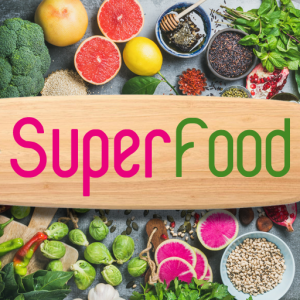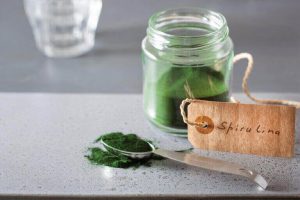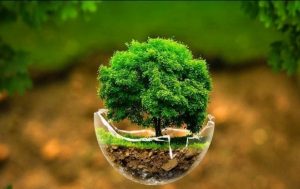If we want to give a general description of spirulina, we have to say that it is a microalgae (invisible to the naked eye), with an ancient origin (2-3 billion years), one of the first plants on earth. In 1964, it was in a landlocked country in central Africa called Chad that botanist Leonard identified the species Spirulina platensis and analyzed blue and green pancakes. This algae grows and multiplies quickly in salty waters rich in sodium carbonate.

A temperature between 28 and 32 degrees Celsius and an environment with a pH of 11 is very favorable for it. Spirulina production has also been reported in Mexico, India and Israel and in many African lakes: Egypt, Ethiopia, Kenya, Democratic Republic of Congo and Zambia. This product has a significant market in America. For example, 450 grams of spirulina powder costs 66 USD.
Spirulina is rich in protein and the richest vegetable in terms of vitamin B.12 and is also considered a very important source of income, but this rich resource is only exploited by a small layer of society in an artisanal way.
Nutrient-rich algae
Nutrient-rich algae, of which spirulina is the most well-known, grown in Chad, also help combat malnutrition. This rich and nutritious crop on July 29, 2010, Rome, led to a better life expectancy for the poor, especially the poor women who harvested this rich crop on the shores of Lake Chad. This nutrient-rich product may one day play an effective role in the fight against malnutrition.
Minerals: Spirulina is a rich source of potassium and also contains calcium, chromium, copper, iron, magnesium, manganese, phosphorus, selenium, sodium and zinc.
Approximate composition
Spirulina has a high quality protein content (59-65%) which is higher than other common ones
Plant sources such as dry soybeans (35%), peanuts (25%) or grains (8-10%). The special value of spirulina is that it is easily digested due to the absence of cellulose in its cell wall. It means that after 18 hours more than 85% of its protein is digested and absorbed. This commercial spirulina powder composition is 60% protein, 20% carbohydrates, 5% fat, 7% minerals, and 3-6% moisture, making it a low-fat, low-calorie, cholesterol-free food.

source of protein
Spirulina protein has a balanced composition of amino acids with a concentration of methionine. Tryptophan and other amino acids are almost identical to casein amino acids, although this depends on the method of use.
minerals
All essential minerals are present in spirulina, with about 7% (average range 2.76-3.00% of total weight) achievable in laboratory conditions. But in the commercial production of spirulina, minerals have a share of about 7%. When it grows in different environments, it accumulates minerals at different temperatures, pH, salinity, etc. With the experiments they conducted, the researchers found that their accumulation capacity has a negative correlation between the accumulated metal and the survival rate of this algae, which affects the optimal breeding process of this algae.
Chelation of toxic minerals (neutralization of toxic minerals)
Spirulina has the unique ability to detoxify (neutralize) or chelate toxic minerals, a property that
It has not yet been confirmed in any other microalgae. Spirulina can be used to detoxify arsenic from water and food. It may also be used for chelation or detoxification.
Toxic effect of heavy metals (minerals) from water, food and environment. Peking University is studying to extract bioactive molecules from spirulina that can neutralize or detoxify toxic substances. Also the effect of heavy metals, and which showed anti-tumor activity. Several institutes in China are focusing on biomolecules that show anti-tumor, anti-aging and anti-radiation properties.
Beta carotene and vitamins
Beta-carotene, group B vitamins, vitamin E, iron, potassium and chlorophyll in spirulina can metabolize carbohydrates, fats, protein, alcohol and reproduce the skin, muscles and mucous membranes. Spirulina contains large amounts of natural beta-carotene and this beta-carotene is converted to vitamin A. Becomes. According to the findings of the National Cancer Institute, USA, consuming 6.0 mg of beta-carotene per day may be effective in minimizing the risk of cancer. If someone consumes 4.0 grams of spirulina per day, which is enough to get 6 milligrams of beta-carotene, they will actually get enough B vitamins, iron, and calcium. However, these nutrients are derived from 4.0 grams of spirulina, meaning something equivalent or more is obtained from eating 100 grams of light green vegetables in 0.4 grams of spirulina.
Spirulina requires less energy per kilo than soy, corn or beef, including solar and generated energy. Its energy efficiency (food energy output/kg/energy input/kg) is five times higher than soybeans, twice higher than corn, and more than 100 times higher than grain-fed beef. Small-scale production of spirulina is considered as a potential income-generating activity for rural households or groups. Spirulina may also be dried and processed for topical use, especially where poor diets require supplementation. In addition, extensive or semi-intensive production of spirulina for animal feed or aquaculture may be carried out for small-scale agriculture and aquaculture. As early as 1949, Spohr and Milner (1949) suggested that mass cultivation of algae would help overcome global protein shortages. Ironically, despite the small per capita supply of protein in many parts of the world, mass cultivation of algae has received only modest attention. The United Nations Environment Program (UNEP) emphasizes nitrogen fixation and nutrient recycling through a program that establishes microbiological centers (MIRCENS), and it is hoped that this will stimulate interest in microalgal technology as part of To stimulate an integrated recycling system especially in rural communities.
Chlorophyll: The most visible pigment in spirulina is chlorophyll. Chlorophyll is sometimes called green blood because of its similarity to the hemoglobin molecule found in human blood cells. Known as a cleansing and detoxifying plant nutrient, chlorophyll increases peristaltic function and thus relieves constipation. It also normalizes the secretion of digestive acids. In addition, spirulina soothes inflammation and reduces excess pepsin secretion associated with peptic ulcers. It has antiseptic properties because it reduces swelling and promotes granulation—the process that regenerates new tissue from injuries, regenerates damaged cells, and improves the overall efficiency of the heart.
Carotenoids Spirulina is the richest food source of beta-carotene, which is a precursor of vitamin A. It has 21 times more beta-carotene than raw carrots, and with a spectrum of 10 mixed carotenoids, about half of that is orange carotene. These are alpha, beta and gamma. These components are semi-xanthophylls that work synergistically in different parts of our body to promote healthy eyes and vision and antioxidant protection.
Phycocyanin is a bright blue polypeptide that is the source of bilirubin (a green pigment that is excreted in bile), which is the most powerful intracellular antioxidant and is related to the human pigment bilirubin and stem cells. Its components are important for healthy liver function and amino acid digestion. Porphyrin Porphyrin is a red compound that forms the active core of hemoglobin. It is necessary for the formation of red blood cells. It is used as a chelator for heavy metal toxicity and circulatory problems. Porphyrins have the ability to bind divalent metal ions due to the presence of nitrogen atoms in the tetrapyrrole nucleus. The central ion in chlorophyll is magnesium, which is released from chlorophyll under acidic conditions and allows other metals to stick in place. Toxic metals such as mercury, lead and arsenic are complexed first, then excess amounts of other divalent metals such as calcium are complexed by porphyrins. By increasing the porphyrin content, the ability to bind heavy metals also increases and provides doctors with a natural and effective “chelating” tool.
Enzymes Spirulina contains a number of enzymes. One of the most important enzymes is superoxide dismutase (SOD), which is important in quenching free radicals and delaying aging. This essential enzyme is very important for the body’s ability to absorb amino acids. Without SOD in the body, we would not be able to make the 10,000 long and complex chains of amino acids known as proteins. In fact, spirulina has such a high enzyme activity that even after drying (at 160°C) it will often start growing again if placed in the right environment, temperature and sunlight. Spirulina has been scientifically proven to increase the reproduction of lactobacilli (the bacteria that digest our food). It contains more than 2000 different enzymes.
Nutritional benefits of spirulina phytonutrients Carotenoids, including zeaxanthin and beta-carotene, support immune health, protect against age-related vision loss, and protect skin from the effects of UV rays. Spirulina contains 4000 mg/kg of carotenoids. Phycocyanin, (gives spirulina its blue color) supports liver and kidney function, key to detoxifying the body. Iron bio-chelate prevents anemia, supports blood health. B vitamins B vitamins, especially B-12, are essential for healthy nerves and healthy hair. GLA The fatty acid GLA supports sexual and menstrual health and reduces PMS symptoms. It also helps balance mood swings and reduces inflammation. Protein The protein in spirulina contains all the essential amino acids that support blood sugar levels and reduce appetite.
Spirulina spp. And its processing products are used in agriculture, food industry, pharmacy, perfumery and medicine. Spirulina has several medicinal activities such as antimicrobial (including antiviral and antibacterial), anticancer, metal protective (prevention of heavy metal poisoning against cadmium, lead, iron, mercury), and also due to its rich protein content. It has immune and antioxidant effects. Polysaccharide, lipid, amino and essential fatty acids, minerals and dietary vitamins. For each application, the basic description of the disease, the mechanism of damage, the specific content of Spirulina spp. For therapy, in vivo and/or in vitro use, factors related to the therapeutic role, problems and advantages are presented.
Spirulina is the richest food in beta-carotene, with a full spectrum of ten mixed carotenoids, about half of which are orange carotenes: alpha, beta, and gamma, and half of which are yellow xanthophylls. They work synergistically in different places in our body to strengthen antioxidant protection. Twenty years of research proves that eating fruits and vegetables rich in beta-carotene gives us real anti-cancer protection. Synthetic beta-carotene has not always shown these benefits. Research in Israel has shown that natural beta-carotene from algae is much more effective. Natural is better absorbed and contains the key 9-cis isomer, which is free of artificial ingredients. As it is believed, natural carotenoids found in algae and vegetables have the most antioxidant and anti-cancer power.

Spirulina is an ideal anti-aging food that is nutrient dense, easily digestible, and rich in antioxidants. Beta-carotene is beneficial for eye health and vision. Spirulina beta-carotene is ten times more concentrated than carrots. Iron is essential for building a strong system, but it is the most common mineral deficiency. Spirulina is rich in iron, magnesium and trace minerals and is more easily absorbed than iron supplements. Spirulina is the highest source of B-12, which is essential for healthy nerves and tissues, especially for vegetarians.
A healthy diet with spirulina is about 60% of the dry weight of spirulina is protein, which is essential for cell growth and regeneration. It is a good substitute for meat and fatty dairy products rich in cholesterol in the diet. Each 10 grams of spirulina can provide up to 70% of the minimum daily requirement of iron and about three to four times the minimum daily requirement of vitamins A (in the form of beta-carotene), B complex, D and K. This vitamin does not contain vitamin C, but it helps to maintain the strength of this vitamin. Spirulina is rich in gamma linolenic acid, or GLA, a compound found in breast milk that helps babies grow healthier. Additionally, with its high digestibility, spirulina has been proven to fight malnutrition in poor communities by helping the body absorb nutrients when it has lost its ability to absorb normal forms of food. Another health benefit of spirulina is that it stimulates beneficial flora such as lactobacillus and bifidobacteria in the digestive tract to promote healthy digestion and proper bowel function. It acts as a natural cleanser by eliminating mercury and other deadly toxins commonly consumed by the body. Spirulina also increases endurance and immunity levels in athletes, and its high protein helps build muscle mass. At the same time, it can control the hunger that may arise during the most demanding training programs. Therefore, it indirectly acts as an effective method to maintain the ideal weight of the athlete’s body
Spirulina contains other nutrients such as iron, manganese, zinc, copper, selenium and chromium. These nutrients help fight free radicals, cell-damaging molecules absorbed by the body through pollution, poor diet, injury or stress. By scavenging free radicals, nutrients help the immune system fight cancer and cell damage. Spirulina helps shrink oral cancer tumors in laboratory mice and thus may represent a major medical breakthrough in cancer treatment. Spirulina’s ability to reduce bad LDL cholesterol in the body helps prevent the onset of cardiovascular diseases such as hardening of the arteries and stroke. It also helps lower blood pressure. Although not clinically proven, spirulina may also protect against allergic reactions and liver infections. Research shows that spirulina improves digestion and bowel function. It suppresses bad bacteria such as E-coli and Candida yeast and stimulates beneficial flora such as Lactobacillus and Bifidobacteria. Healthy flora is the foundation of health and increases the absorption of nutrients from the food we eat and helps protect against infection. Spirulina makes Lactobacillus healthy and helps to absorb and eliminate constipation.
Detoxing In 1994, a Russian patent was granted for spirulina as a medical food to reduce allergic reactions caused by radiation sickness. 270 Chernobyl children, given 5 grams per day for 45 days (donated by Earthrise Farms), reduced radionuclides by 50% and normalized allergic sensitivities. Spirulina has a completely unique combination of phytonutrients including chlorophyll, phycocyanin and polysaccharides that can help cleanse our bodies.
For beautiful skin, spirulina is one of the best anti-aging agents. It nourishes the skin well. You simply add 1 tablespoon of spirulina to your juice or smoothie. But before eating, apply some of it on your face. Allow to dry and then rinse, then color and moisturize. See the magic in just 3 weeks. Spirulina is rich in vitamin A (in the form of beta-carotene), an antioxidant widely recognized for maintaining healthy skin. Beta-carotene helps slow skin aging caused by UV rays. It also helps protect the skin from sunburn. Spirulina is also a powerful source of the antioxidant superoxide dismutase (SOD), which helps oxygenate the skin and helps protect the skin from UV damage. In addition, spirulina contains unusually high levels of polyunsaturated fatty acids, such as gamma linolenic acid (GLA), which contribute to skin elasticity. Consume the right amount of spirulina daily along with carrots, sprouts, oatmeal, oranges, lemons, pumpkin, parsley, purified water and herbal teas.
Anticancer Effects It has been argued that the antioxidant composition and immunomodulatory properties of spirulina may have a possible mechanism of tumor destruction and hence play a role in cancer prevention. While there are many animal and laboratory studies, only one human trial has been conducted. This study specifically looked at the effects of spirulina on oral carcinogenesis, specifically leukoplakia. Not surprisingly, there are few human studies to date because cancer prevention trials with lower cancer incidence as endpoints have logistical problems that make them essentially impossible to conduct for most malignancies. The study by Mathieu et al. (1995) on a group of 77 patients originated from previous experiments on hamsters that showed tumor regression after topical application or administration of spirulina extract. They reported that 45% of their study group showed complete regression of leukoplakia after taking spirulina supplements for 1 year. The authors also reported that no increase in retinal serum β-carotene concentrations was observed despite supplementation, and concluded that other compounds in spirulina may be responsible for the anticancer effects. Even though their results look promising, this was a blinded, non-randomized trial and therefore cannot be considered as evidence of a positive effect.

Antioxidant and antiproliferative activity: Treatment of liver cirrhosis Liver fibrosis is a chronic liver disease that turns into cirrhosis if severe damage continues. A potential treatment for liver fibrosis is to inhibit the proliferation of activated hepatic stellate cells (HSC) or by inducing HSC apoptosis. It was shown that spirulina prevents the proliferation of HSCs in the G2/M phase with its antioxidant activity. The main component of spirulina that plays an antioxidant role is C-phycocyanin. This study was performed on HepG2 cells (human liver cancer cells).
Spirulina and Chronic Fatigue Spirulina has been touted as the “food of the future” with “exceptional ingredients” that contribute to high energy levels. Some of these compounds such as polysaccharides (rhamnose and glycogen) and essential fatty acids (GLA) are easily absorbed by human cells and help release energy. Spirulina increases healthy lactobacillus in the gut and produces vitamin B6, which also helps release energy. Despite this improvement, the only randomized placebo-controlled trial available showed no significant difference in fatigue scores between spirulina and placebo. Spirulina administered at a dose of 3 g/day did not improve fatigue more than placebo in any of the four subjects and is unlikely to have an effect on chronic fatigue.
Allergy, Rhinitis, and Immunomodulation It is well documented that spirulina exhibits anti-inflammatory properties by inhibiting the release of histamine from mast cells. In a randomized, double-blind, placebo-controlled trial, subjects with allergic rhinitis were fed placebo or spirulina daily for 12 weeks. Peripheral blood mononuclear cells were isolated before and after spirulina feeding and the levels of cytokines (interleukin-4 (IL-4), interferon-γ (IFN-γ) and interleukin-2 (IL-2)), which are important in regulating . Immunoglobulin (Ig) mediated allergy was measured. The results showed that a high dose of spirulina significantly reduced IL-4 levels by 32%, indicating the protective effects of this microalgae against allergic rhinitis. Spirulina on human salivary IgA levels and has been shown to increase IgA production, indicating a central role of microalgae in mucosal immunity.

A Japanese team identified the molecular mechanism of spirulina’s human immune capacity by analyzing the blood cells of volunteers with pre- and post-oral administration of hot water extract of Spirulina platensis. IFN-γ production and natural killer (NK) cell damage were increased after microalgal extract administration to male volunteers. In a recent double-blind, placebo-controlled study in Turkey that evaluated the efficacy and tolerability of spirulina for the treatment of patients with allergic rhinitis, spirulina administration significantly improved symptoms and physical findings compared to placebo, including nasal discharge, Relieve sneezing, nasal congestion and itching. It is well understood that nutrient deficiencies are responsible for changes in immunity characterized by changes in T cell production, secretory IgA antibody response, cytokines, and NK cell activity.
Cholesterol-lowering effects on diabetes
Despite increasing awareness and increasing cholesterol as one of the most important risk factors for atherosclerosis, cardiovascular disease is the first cause of death in developed countries. In the first human study, Nakaya et al. (1988) gave 4.2 g/day of spirulina to 15 male volunteers, although there was no significant increase in high-density lipoprotein (HDL) levels, they found a significant decrease in low-density lipoprotein (LDL). They saw. Cholesterol after 8 weeks of treatment. The atherogenic effect was also reduced. In a more recent study, Rama Murthy and Prema Kumari (1996) administered spirulina supplements to ischemic heart patients and found significant reductions in blood cholesterol, triglycerides, and LDL cholesterol and increases in HDL cholesterol. In a clinical study, they found a significant reduction in the LDL:HDL ratio in 15 diabetic patients who received spirulina. However, this study showed that small spirulina can be recommended in diabetes.
Therefore, the positive effects of spirulina in allergic rhinitis are based on sufficient evidence, but larger trials are needed. Anticancer effects of spirulina may be due to β-carotene (antioxidant). However, the association between beta-carotene levels and carcinogenesis cannot be considered as the cause of cancer. There are positive studies on the cholesterol-lowering effects of spirulina, but more studies are needed before definitive conclusions can be drawn. Finally, there are no high-level evidence trials on the role of spirulina in chronic fatigue and antiviral applications. Currently, the literature suggests that spirulina is a safe dietary supplement with no significant side effects, but its role as a drug is still unclear.
And these are only some of the many properties of spirulina.
Roya Algae Pars Company is proud to cooperate with those interested in the production, breeding and processing of spirulina algae.










